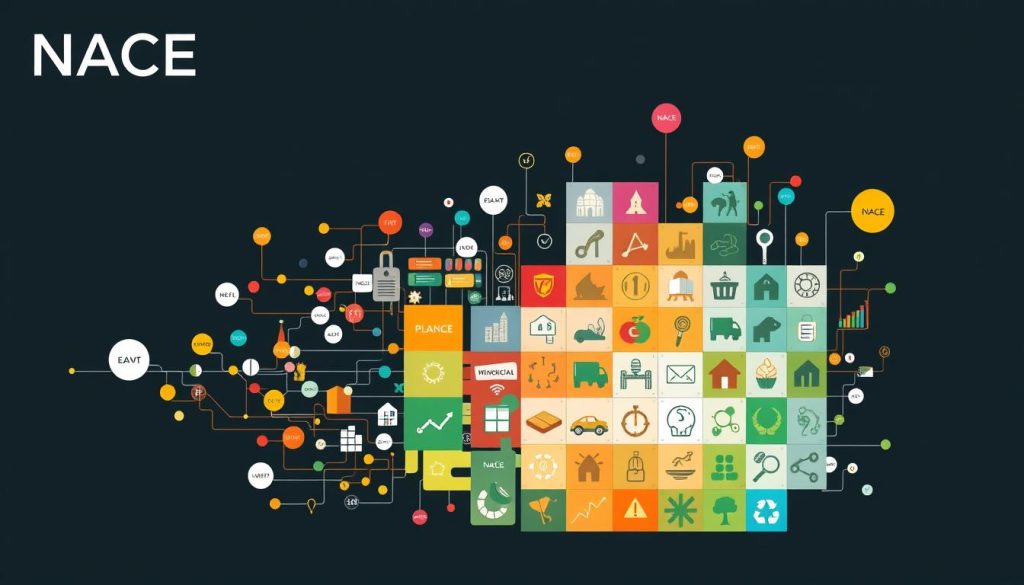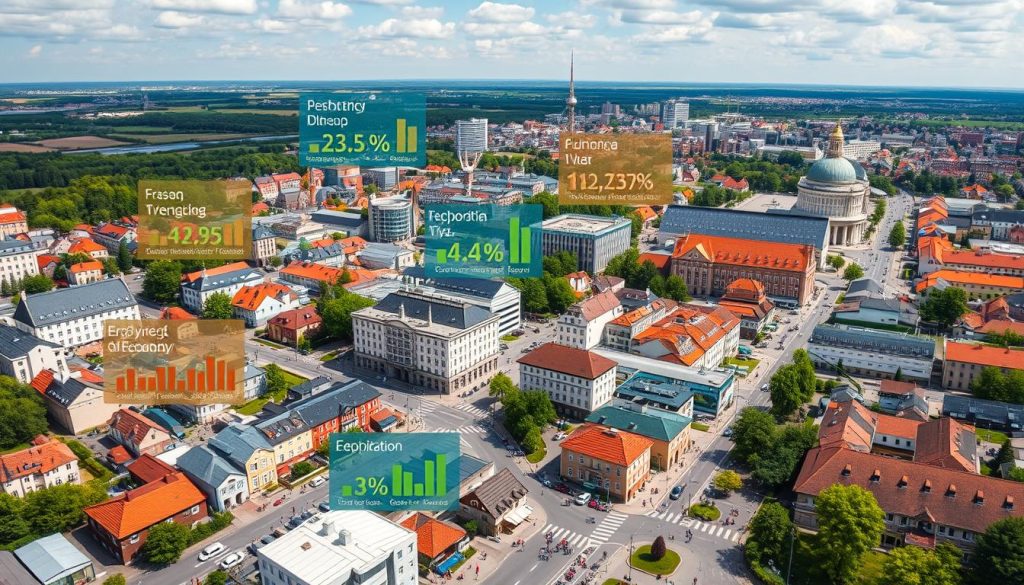In our look at Structural Business Statistics (SBS) in Lithuania, we see its key role. It sheds light on the country’s business world. These stats give a detailed look at different economic activities, like industry, construction, and services.
They use the NACE system to sort businesses and guide policy choices. This helps us grasp how businesses are organised and their impact on the economy.
SBS are vital for governments, analysts, and businesses. They help make smart choices and understand economic changes. With recent issues like the COVID-19 pandemic, knowing these stats is crucial. It helps us get through Lithuania’s changing business scene.
Introduction to Structural Business Statistics
Knowing what structural business statistics are is key for many. It’s important for economists, policymakers, and business leaders. These stats give us a big picture of how businesses are doing in Lithuania. They help us see how well business plans are working.
These statistics are also vital for making data available to everyone. This helps with starting new businesses, growing wealth, and understanding jobs. It’s all about making smart economic choices.
Definition and Significance
Structural business statistics cover a lot of ground in Lithuania’s economy. They include info on new and closed businesses, loans to small firms, and how different sectors are doing. This data is crucial for making good policies, supporting new businesses, and showing how the economy is doing.
Having accurate SBS helps everyone understand business better. It helps in making choices based on solid data.
Overview of the Business Economy
In Lithuania, the business world is diverse. It includes everything from construction to services, under NACE Rev. 2. This lets us see how each sector contributes to the economy. It shows us about productivity, profits, and jobs.
By looking at these areas, we see how important businesses are. They play a big part in Lithuania’s economy.
Key Components of Business Statistics in Lithuania
Business statistics in Lithuania help us understand the economy. Key parts include the NACE classification, how businesses are grouped, and the size of these businesses. These elements help us see how different sectors contribute to the economy.
NACE Classification Explained
The NACE classification is key for sorting businesses by their economic role. It makes data collection and analysis easier across the European Union. This way, we can compare businesses in Lithuania with others in the EU.
It covers many sectors, from making things to services. This lets us deeply understand Lithuania’s economic activities.
Categorisation of Enterprises by Size
In Lithuania, businesses are sorted by how many employees they have. The sizes are:
- Micro enterprises: 0-9 employees
- Small enterprises: 10-49 employees
- Medium enterprises: 50-249 employees
- Large enterprises: 250+ employees
This helps us see how different sizes of businesses work and face challenges. It shows how small and medium-sized businesses are crucial to the economy.
Scope of Structural Business Statistics
Structural business statistics cover many important indicators. These include how much value is added, the number of workers, investments, and how businesses change. By looking at these, we can see how the economy changes and how different businesses help it grow.

Trends in Structural Business Statistics in Lithuania
Looking at structural business statistics in Lithuania gives us key insights. It shows how businesses in the area are doing. The balance between new businesses starting and old ones closing tells us a lot. Also, big changes worldwide have made a big impact on how businesses work.
Enterprise Birth and Death Rates
In Lithuania, the number of new businesses is growing, showing a strong will to start up. This rate is higher than the EU average, which is good for new companies. But, the number of businesses closing is a worry, especially in fast-growing areas.
Many firms struggle because of changes in the market and tough economic times. Looking at these numbers helps us see how well the business world is doing. The success of new businesses is key to the economy’s health.
Impact of COVID-19 on Business Dynamics
The COVID-19 pandemic has changed how businesses in Lithuania work. It forced companies to find new ways to meet customer needs and keep running. Now, more people work from home, which is common in many industries.
How people spend money has also changed, pushing businesses to go digital faster. This means policymakers need to think about these changes when planning for the future. They must help businesses grow and stay strong in this new world.
Structural Business Statistics in Lithuania
Understanding the economic contributions of different sectors is key to grasping Lithuania’s business scene. By looking at structural business statistics, we see how manufacturing, services, and trade drive the economy. Each sector adds its own value and employment trends, shaping our economy.
Economic Contributions of Different Sectors
The manufacturing sector is crucial for Lithuania’s GDP. In 2022, it produced about €2,420 billion in value added. This shows its big role in the economy. On the other hand, services are vital for jobs, making up the largest share of employment in the EU.
Employment and Value Added Trends
Employment and value added vary across sectors. The distributive trade sector, for example, employed over 29.8 million people in 2022. It also added €1,591 billion to the economy. Different regions in Lithuania have different productivity levels, influenced by local conditions and sector strengths.
This diversity means we need specific strategies to grow and invest. We must make sure each sector’s unique contributions to employment and value added are valued and increased.

Role of SMEs in Lithuania’s Business Economy
Small and medium-sized enterprises (SMEs) are key in Lithuania’s economy. They make up 99.8% of all businesses. This shows how important they are in creating jobs and adding value in many areas.
SMEs are also crucial for innovation and starting new businesses. This keeps our business world lively and competitive.
But, SMEs face big challenges, especially with the shift to cleaner energy. They often struggle to get the info and money needed for green practices. Many know about the changes in energy rules and want to cut emissions. But, they need help to do it right.
Financial help for SMEs can make a big difference. Easy-to-use schemes and loans can help them grow. For example, the ILTE guarantees can cover up to 80% of a loan. This makes it easier for SMEs to invest in new tech and ideas.
For SMEs to join the energy shift, they need specific advice and support. The EMBank initiative helps a lot. It guides SMEs through the process of getting ILTE guarantees. This support makes it easier for them to grow and succeed.
Conclusion
Looking back at our study of business statistics in Lithuania, we see how important data is. It helps make better decisions in many areas. The economy has seen ups and downs, like a 0.3% drop in 2023 due to less spending by people.
But, there’s hope with a 2.4% growth in real output in the first half of 2024. This shows Lithuania’s economy is strong. It also shows good signs like more jobs and lower prices for things people buy.
Small and medium-sized enterprises (SMEs) are key to Lithuania’s economy. They keep growing even when things get tough. With about 2,000 new SMEs every year, they are crucial. Knowing how they help the economy is important.
As we face the challenges of the economy, keeping a close eye on things is essential. This helps Lithuania grow and develop in a good way. Supporting all businesses, big or small, to keep up with changes is vital.

